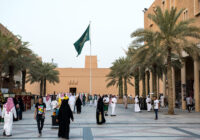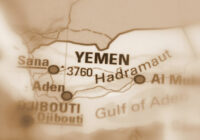As the war in Yemen splinters, the distribution of humanitarian assistance becomes increasingly difficult. The situation throughout northern Yemen — territory under the control of Houthi rebels — is wrapped into the conflict over restricted access to Hodeida seaport under UN Security Council Resolution 2216 (2015) and very limited access to Sanaa International Airport by humanitarian agencies.
In southern provinces, political rivalries present major obstacles to the coordination and delivery of aid. Another problem has been a failure by the international community to meet funding requests, often falling short by up to 50%. Where available, the more direct, government-driven humanitarian funding might prove to be a more effective approach, especially when it comes to long-term solutions.
How China’s Growing Dominance Will Impact Sino-Gulf Relations
Nearly seven years into the Yemeni conflict, no party is closer to a military victory, and the main tactic by all sides has been to dilute local authority to foment chaos. The current situation along southern provinces is clear evidence of these tactics — from Abyan to Mahra. Economic development remains stagnant, while infighting and turf wars obstruct operations by humanitarian agencies.
In Aden, for example, UN agencies and nongovernmental organizations (NGOs) are constrained by conflict over access to ports and collection of tariffs, checkpoints, corruption and fighting at the village level outside the province. Abyan is now divided into three spheres as a result of fighting among the Southern Transitional Council (STC), pro-Islah forces and elements loyal to President Abd-Rabbu Mansour Hadi. The conflict in Shebwa has carved space for aid agencies from Turkey and Qatar working through al-Islah affiliates. Yet failure to stabilize these local environments has exacerbated the humanitarian crisis, while some profit from the war economy.
Stabilization of local environments, eliminating obstacles such as checkpoints and corruption have proved key to the effective delivery of aid and social cohesion. While political rivalries prolong conflict across Yemen, instances of political victory over rivals provide isolated models of stability.
In the case of the Soqotra archipelago off the coast of Yemen, the end of the political conflict between al-Islah affiliates and southern elements has led to an increase in the flow of aid, the absence of political strife and a gradual restart of economic activity. International organizations have had limited access to the island, but direct government assistance from coalition members has bolstered the pace of development.
A Direct Model
During the conflict, donors have failed to meet funding requests from humanitarian agencies. As demand has increased, donor contributions have dropped. It is estimated that over 3.5 million civilians have been displaced from their homes, while over 24 million “are in need of humanitarian assistance.” The funding gap has grown between 40% and 60% from 2019 to the present. The capture of humanitarian assistance by Houthis since 2019, amounting to an estimated $1.8 billion, has also created problems for UN agencies and NGOs when donors have lost confidence and perceive their contributions will end up funding the war.
Direct funding of small projects — in the health sector or for economic actors — by donor governments could relieve political tension and contribute to local stability. The case of Soqotra again allows for potential modeling under current circumstances. Since 2015, as the armed conflict expanded, the Yemeni island in the Indian Ocean has received direct humanitarian assistance from the United Arab Emirates. Soon after cyclone Chapala struck Soqotra in 2015, the UAE delivered life-saving aid. It also supported the population after the Makunu cyclone in 2018.
Over the past six years, the UAE has delivered over $110 million in assistance to the population on Soqotra and neighboring islands. The aid has reached areas of social and health services, transport and storage, fishing sector, construction, public education, energy and potable water.
While millions have been displaced by the war on the mainland, rapid response assistance following Chapala and Makunu prevented the displacement of hundreds of families. With help from the UAE military, organizations such as the Abu Dhabi Development Fund (ADFD), the Khalifa bin Zayed Al Nahyan Foundation and the Emirates Red Crescent (ERC) helped build 161 residential units in Zayed City, 21 in Dafarh, 51 in Arshani, and other units in Zaheq and Dixam since the cyclones hit the islands. Assistance has also provided four power plants, a distribution network for more than 30 sites, installed solar-powered street lighting and established two solar power plants in Hadibo with a capacity of 2.2 megawatts and Qalansiya at 800 kilowatts.
Direct aid from the UAE has also reached Soqotra’s health sector. By specifically targeting the needs of the local population, after natural disasters or ordinary health requirements, the assistance has fully equipped one emergency facility and two surgery rooms. It has also added 13 beds and an intensive-care unit (ICU) in line with international standards and expanded the Sheikh Khalifa Hospital. The facility’s bed capacity has increased to 42, including four at the ICU unit, and 16 CT scan machines have been installed.
Assistance for economic actors has also focused on the Fishing Cooperative Union and 27 fishermen’s associations, helped renovate a fish market and built a fish factory with a production capacity of 500 tons per month, employing 500 local people. Financial assistance has also reached farmers, converting over 31 hectares into farmland.
Stability as a Model
Civilian organizations continue to face challenges while delivering aid in remote areas of Yemen. Obstacles include funding gaps, import logistics and costs, and access to ports and roads. In the case of Soqotra, NGOs have been unable to respond to natural disasters and growing needs in the health and energy sectors.
The end of the armed conflict may be further than expected at this time, but where possible, the extinguishing of political rivalries has produced wider access for the delivery of humanitarian assistance. Soqotra stands as a potential model, at the micro-level, in hands of a party within the government coalition prescribed by the Riyadh Agreement, a power-sharing deal for Yemen.
As a legitimate party representing the southern people according to the Riyadh Agreement, the STC is a partner in Yemen’s internationally recognized government under President Hadi. The progress achieved in securing order and promoting social cohesion could provide a model for other areas throughout liberated provinces. An essential component of success remains direct access to sustainable funding from donors.
The views expressed in this article are the author’s own and do not necessarily reflect Fair Observer’s editorial policy.
Support Fair Observer
We rely on your support for our independence, diversity and quality.
For more than 10 years, Fair Observer has been free, fair and independent. No billionaire owns us, no advertisers control us. We are a reader-supported nonprofit. Unlike many other publications, we keep our content free for readers regardless of where they live or whether they can afford to pay. We have no paywalls and no ads.
In the post-truth era of fake news, echo chambers and filter bubbles, we publish a plurality of perspectives from around the world. Anyone can publish with us, but everyone goes through a rigorous editorial process. So, you get fact-checked, well-reasoned content instead of noise.
We publish 2,500+ voices from 90+ countries. We also conduct education and training programs
on subjects ranging from digital media and journalism to writing and critical thinking. This
doesn’t come cheap. Servers, editors, trainers and web developers cost
money.
Please consider supporting us on a regular basis as a recurring donor or a
sustaining member.
Will you support FO’s journalism?
We rely on your support for our independence, diversity and quality.







